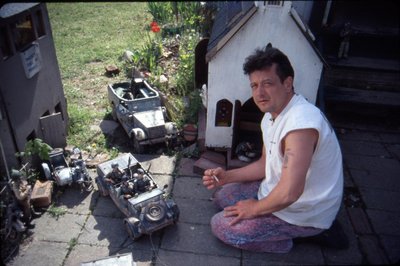“Marwencol,” opening at Ritz Nov. 19, is an absolutely spellbinding documentary about Mark Hogancamp, an unusual artist who creates and photographs a 1/6-scale World War II-era Belgian town in his backyard. He names the town Marwencol after himself, Mar(k), and two female friends, Wen(dy) and Col(leen).
Building the town and creating a story for the “people” in it — all Barbie dolls and action figures — provides a way for Hogancamp to cope after being beaten senseless by five men on April 8, 2000. The attack left Hogancamp, then 38, in a coma for nine days. He needed to have his face rebuilt. He lost his memory and relies on old photographs and videos to remind himself that he was once married. A talented sketch artist, he required therapy to learn how to simply write again. Perhaps the one benefit of his debilitating brain injuries was that the once-alcoholic Hogancamp completely lost his taste for liquor.
Filmmaker Jeff Malmberg does more than just provide a portrait of a unique individual who survived a terrible tragedy. “Marwencol” explores issues of identity — Mark goes from “Who am I?” to “Who I am” — as well as the difficult process of going public with something that is intensely personal. What is most astonishing about Hogancamp’s story is how this vulnerable man has been protected, not exploited, by the filmmaker and the folks he encounters in his recovery.
“Marwencol” shrewdly tells two stories. The first is about Mark himself — how he is given a second chance at life, and how he wants to take full advantage of this, despite his limitations. Whereas he used to draw beautifully, he now takes photographs. When David Naugle, a photographer, notices Mark and learns about his project, he helps Mark publish his photographs in the magazine “Esopus.” The publication’s editor appreciates not only the authenticity of Mark’s work, but also its lack of irony. This exposure eventually leads to an exhibit of his work at the White Columns gallery in Greenwich Village. Mark soon has to conquer his fear of showing his work in New York City. The film chronicles how he faces this challenge, and watching the anxious Mark muster his courage is both fascinating and rewarding.
The other story is the narrative that takes place in the fictional town of Marwencol. Here, Mark uses his art as therapy. He populates his town with dolls, naming them after the friends, neighbors and coworkers each one resembles. (Amusingly, the Pussy Galore doll from the James Bond series is given his mother’s name, Edda.) Creating these “alter egos” and giving these characters storylines helps Mark work out not only his patience and dexterity — which were damaged in his attack — but also his imagination, which he feared was lost too.
And just as Mark hopes to live fully in his real life, within the confines of his fantasy world, Mark allows his characters to do things they could never do in reality. He uses the dolls to work out his anger issues. When his Capt. Hogancamp is captured by the SS, he is tortured by five men — just as Mark was. The doll has a scar on the right side of his face, where Mark himself was injured. But he exacts a nasty, satisfying revenge on his attackers, of which Mark can only dream.
Truth and fantasy may blend in Marwencol, but Mark seems adept at separating the two. There is a simplicity and charm to the film’s subject in his interviews, and Hogancamp is ingratiating. Malmberg presents Mark and his quirks without judgment, and viewers come to respect and admire him. It may be a little odd that the adult “plays” with dolls, hugging them and telling them he loves them, but there are reasons for this behavior. It helps Mark cope with his trauma: He is not advocating that others emulate it, though he would like a girlfriend to play with him and his town.
Mark uses Marwencol to fantasize about the romance he would like to have. The point of how the town creates a safe space for the damaged Mark is made, and it’s a powerful message.
As the film shows, Mark’s friends applaud his elaborate art project, but there is a concern that outsiders, who don’t know him, will not understand it. This is where “Marwencol” considers how going public — likening it to coming out — with something so personal can be cause for rejection, misunderstanding and pain. The analogy will especially resonate with queer viewers.
“Marwencol” judiciously addresses Mark’s justified concerns. As he eventually and unexpectedly reveals what may be the root of and cause of his fears, he also discloses what may have been the motivation for his attack and the subsequent inspiration for his town. (Chilling testimony from one of his assailants confirms this.) At this point, Mark’s already-remarkable story takes another, greater dimension.
Ultimately, Malmberg’s film is a testament to the strength of human resilience, and how people cope by finding a positive way of battling — if not overcoming — their inner demons. Hogancamp’s story is truly inspiring, and possibly the most extraordinary story — real or imagined — to be told all year. Don’t miss it!
